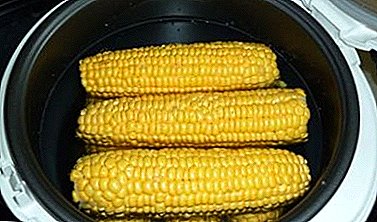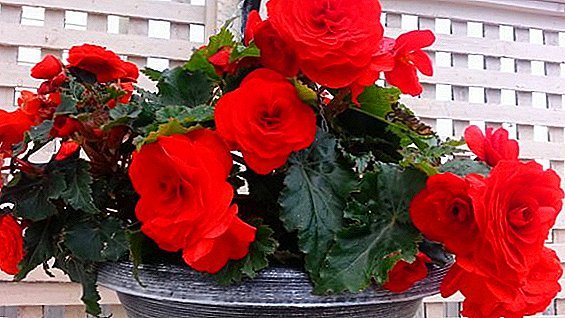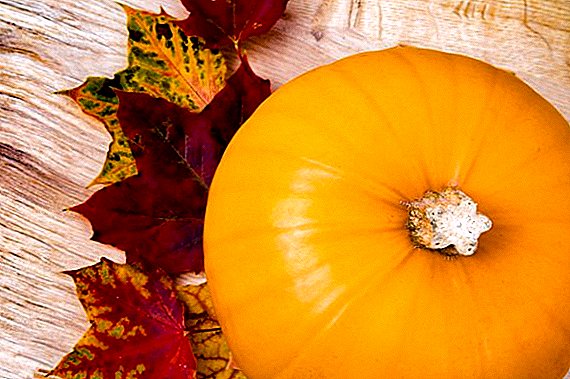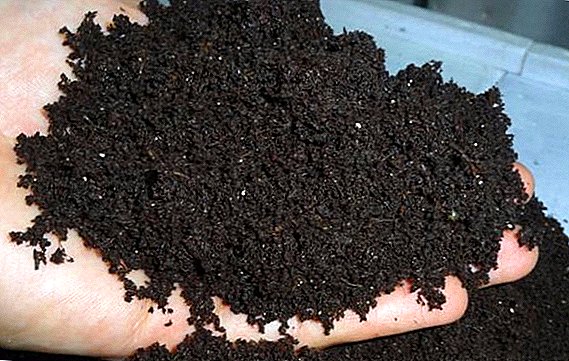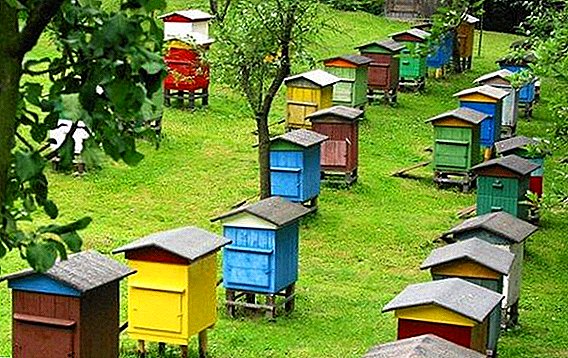 Beekeeping is a complex science that includes both theoretical and especially important practical knowledge.
Beekeeping is a complex science that includes both theoretical and especially important practical knowledge.
Only patient and truly dedicated people to this business could, with practical methods and many years of experimentation, comprehend its essence.
Vladimir Petrovich Tsebro belongs to such research beekeepers. This outstanding practitioner beekeeper and theorist has developed the most effective beekeeping program, called the Tsebro method.
Fundamental rules
His entire method, based on the progressive structure of the hive, bee-free keeping of bees with the performance of work on the schedule and schedule, a special method of bee breeding and expansion of the apiary without additional purchases of queens and families, V. Tsebro described in multi-volume instructions.
Its method is characterized by an increase of almost three times the number of bee colonies by the time it takes to collect honey, the regular renewal of queens in all bee colonies without the need to acquire new young, which occurs every year, and to combine, in order to winter, the three families to one by force.
According to the method of beekeeping Tsebro, quite large, capacious hives consisting of three buildings should be used in the apiary: subsequently they began to be called Hives Tsebro.  Such a design of hives contributes to the expansion of bee families in the spring: the second building is mounted on top of the hive, shops do not need to be installed, so the family can be divided, if there is a young queen, into two separate ones, which allows increasing the number of families at an accelerated pace.
Such a design of hives contributes to the expansion of bee families in the spring: the second building is mounted on top of the hive, shops do not need to be installed, so the family can be divided, if there is a young queen, into two separate ones, which allows increasing the number of families at an accelerated pace.
A mother of two weeks is quite realistic to create two layers, which will simplify the task of having a new uterus.
From the new layers, create a normal strong separate family - for her and set the top floor.
Layers are applied separately during late bribe. Layers are attached to the family, which allows you to change the old uterus to a younger one.
Prospective families with excellent characteristics should be provided with the necessary food (honey, perga), evenly distributing it between the frames. All this is done after the extraction of honey and the formation of families.
For normal conditions of existence, it is possible to combine nests from several buildings during the winter: in the second place frames with sockets, in the lower one - store frames.
Important! The main point in the content of bees is the creation of sufficient ventilation in the buildings with no drafts.
Next season you need to use strong families. If you adhere to the proper maintenance and care of hives, they will eliminate the appearance of bee diseases.
Constant airing and blowing of hives with fresh air contributes to their drying out, and no pest that is dangerous to bees tastes like a dry climate. It is desirable that the cells were always disclosed.
Under the frames there is no need for additional expansion, since there may be a place for blowing cold air. The optimal size of the space under the frame - three centimeters.
The reproduction of bees is recommended in the second branch, since the number of bees is 1.5 times more weighty in it, and the existence of a young uterus also contributes to this choice.
The old uterus loses its relevance, and because of its uselessness it is removed, the rest of the bees return to the family. 
Important! It is necessary to constantly conduct the process of observing the bees: on which plants they like to “graze”. Watching such a process, one can always correctly plan the route for moving hives from one honey-bearing area to another, taking into account the timing of flowering of honey-bearing plants.
In the two-case hives, there must always be a grate so that the uterus cannot get into the upper compartment, and all the bees after that do not come to a swarm.
Queen bees change annually. Queens are best received from families with a reserve of strength and health.
The uterus, capable of reproduction, has a large abdomen, which tend to drag, and a rather heavy tread. The uterus, which can not give offspring, has a light abdomen with some elevation.
To obtain eggs, it is necessary to choose from the insulator only high-quality honeycombs without defects and drones. Frames for the purpose of vaccination are determined in families without queens, where upbringing takes place with brood that has a different age.
Familiarize yourself with the ways of hatching bees.
 This allows you to count on nurse bees with royal jelly, the value of which is difficult to overestimate for puberty of the future uterus.
This allows you to count on nurse bees with royal jelly, the value of which is difficult to overestimate for puberty of the future uterus.For honey, honeycombs are placed for a day in a warm place with a temperature of 27 ° C.
Important! The best version of the honey extractor is an electric for thirty-two frames, with which you can pump up to two cans of honey at a time. Then it must be filtered with a sieve and gauze in several layers. This procedure contributes to the purification of honey from pollen and wax.
Dead bees must be given after wintering for research to make sure that the cause of death is not in the disease.
In the care of bees, it is recommended to strictly adhere to the work, according to the calendar.
Tsebro placed twenty-five families in each place, equalized them with the distribution of brood - did it during any inspection.
Rasplod received from families in nine-ten streets, a family of four streets combined. For each hive, he put forward a requirement - respect for the ratio of volume and strength that the family has.  In the care of the bees, Tsebro used a group approach. He skillfully used in practice the characteristics of bees at all six stages of the family life cycle throughout the year.
In the care of the bees, Tsebro used a group approach. He skillfully used in practice the characteristics of bees at all six stages of the family life cycle throughout the year.
Hive structure
According to the Tsebro method, bees need to be in beehives from walls with a double structure without a warming layer between its parts from forty-four frames measuring 435 by 300 millimeters.
On the case-base of fourteen frames, you can mount a couple of additional out of ten frames and a pair of five. The structure under the roof, made of thin boards, continues the walls of the hive, the height of which is designed for two buildings.
To make it more convenient, the left side of this structure is hinged and can be folded down. The roof also opens on its hinges, rising vertically.
Learn about the features of the advantages of using the Dadan hive, alpine, nucleus, multicase hives and bee pavilions.In the side parts of the roof trim there are closed and darkened windows for ventilation, measuring two and a half centimeters. The hive has a tray that can be taken out. All Tsebro's bee colonies always stayed in permanent places and experienced wintering in freedom. With the arrival of spring, the nests in ten or more streets, in which the main families were located, expanded to fourteen frames.
In the nests of paternal families, honeycombs were placed in the center, with the aim of obtaining early drones. The nests were covered with foil or canvas, insulated, the upper feeders with water were left free for the bees.
Did you know? In the hive can live from sixty to one hundred twenty thousand bees.
Features output uterus
The Tsebro method is especially appreciated for recommending artificial breeding of queens from eggs that are only two days old.  The main principle of this method is the division of the family through the intermediation of grids intended for such a purpose as soon as the family begins to exceed nine brood frames.
The main principle of this method is the division of the family through the intermediation of grids intended for such a purpose as soon as the family begins to exceed nine brood frames.
The withdrawal of queens according to the method of Tsebro will occur in the lower floor. At the end of April, when there are approximately eight to nine frames with brood in the family, the next building of ten frames can be placed on top.
They are transferred from the lower tier with bees along a pair of frames with food, four with brood and four sushi for sowing, which are mixed.
At the bottom of the frame in the amount of ten pieces were placed as follows: a frame with feed, one with waxing, two with brood, one with waxing, two with brood, one with waxing, one building, frame with food.
At this stage, the grid for separation is not needed. The uterus from the bottom, having no work there, moved to the upper floor.
Approximately ten days later, the bees from the frames on top were shaken off along with the uterus to the lower floor, where the bees settled down the foundation almost by one third. After that, a grid was placed to separate the floors. 
Important! All actions must be carried out, according to the Cebro method, in a certain sequence without any initiative, otherwise the conflict that has arisen in the hive can provoke its death.
Further, almost at the same time, in families, queens are detected and attached to insulators, which are located on the comb and are placed between frames with brood. In a couple of days, layings with tribal uterus are created.
Four frames with bees from the upper floor are placed in packet drawers along with queen bees from an insulator. Everything closes. From the lower floors upward feed frames without bees in the same amount, they are replaced with honeycombs with eggs from the insulator.
In the lower tier between the frames with the brood it is necessary to make three wells for the grafting frames. Parent families are transformed into educators.
Further frames with two-day eggs need to pull out and put in a box, for example, in the car, where the honeycomb are separated by a hot knife into strips of one cell in a row.
Eggs need to be thinned, leaving one after two, place the strips on the slats of the framework for vaccination, which should be placed in the created wells, and in the place where the frame with two-day eggs used to be placed.  The lower tier with families, teachers must be warmed. After that, the tribal uterus is located in another place and placed in a hive, consisting of ten frames, which will be to the right of the raising families.
The lower tier with families, teachers must be warmed. After that, the tribal uterus is located in another place and placed in a hive, consisting of ten frames, which will be to the right of the raising families.
Breeding nests are supplemented with honeycombs up to eight. After twenty days have passed since the first tiers of the hives have been set up, the formation of layers should be started. At this moment, fully matured queen cells have already formed.
It is necessary to provide a couple of frames of feed to the one body from the main bee family, the same brood and one sushi with water, and then make the bees shake off the frames and fall into the lower tier, where the queen was already.
You will probably be interested to learn about the breeding of bees by layering.The tier that leaves young bees leave is the backbone of the next swarm. After three days, the second layers are created and placed on the half of the body in front of the first: both of them add queen cells.
Next, each of the layers four times in the next ten days must be reinforced frame printed brood.  By the beginning of the main collection of honey, the new layers are in effect and may well bring real honey, like members of the main family.
By the beginning of the main collection of honey, the new layers are in effect and may well bring real honey, like members of the main family.
Although according to the description, the Tsebro method may seem rather complicated, but in reality everything is very accessible and simple enough, the main thing is to follow the exact instructions. With the observance of this method, each bee family is able to bring up to two hundred kilograms of honey.
We recommend you to read about such types of honey as black-maple, hawthorn, esparcetovy, linden, facelle, coriander, acacia, chestnut, buckwheat, rapeseed, sweet clover, cypress.
Bees wintering
An important positive factor in favor of the Tsebro method is the excellent wintering rates for bee colonies.
Beekeeping masters perfectly understand the responsibility of creating optimal conditions for the wintering of their ward bees. The whole uniqueness of the Tsebro method in this matter lies in the design features of the hive itself.
Hive are built from several buildings and consist of double walls without insulation. This all makes them look like an apartment building in which an apartment needs to be heated less than a separate private house that has the same area.  Stores for the winter can be placed in the hive, only if it is very necessary. With hives before the onset of winter you do not need to rush, they remain in place.
Stores for the winter can be placed in the hive, only if it is very necessary. With hives before the onset of winter you do not need to rush, they remain in place.
Preparing bees for winter, you need to remove the feeders and medical strips, remove all insulating materials from the upper hulls for the purpose of cooling, so that the bees descend lower, unite and create clubs for wintering.
Even in winter, ventilation processes take place in the hives due to the lower entrance holes and openings that are a few centimeters wide open, which are located among the ventilation bars, which were specially designed for winter.
You should also not forget to leave, especially for strong families, food in the form of honey and perga. Technologies and principles of the Tsebro method allow bee colonies to survive the real frosts with success.
Did you know? Bees do not sleep in the winter, so they need an adequate supply of food for the winter.

Tsebro beekeeping (beekeeper calendar)
Bees are loving creatures, their vital activity takes place according to certain natural cycles. They do not like vanity and uncertainty.
These insects are very sensitive to any changes in weather, temperature and light conditions, humidity and much more. The calendar, derived by Tsebro, takes into account all these nuances, and also is based on the main practical principles of the work of its author.
According to the Tsebro calendar, in January, monitoring and listening to how the bees feel during the winter occurs, submor is also removed, new honeycombs are created, the beehive is warmed, the insulation is checked.
In February, it is necessary to analyze non-surviving bees in the laboratory in order not to miss such diseases as Nozematoz, Varroatosis and Ascosferosis.  Preliminary examination of families that have almost survived the winter, and their qualitative condition. If necessary, take appropriate action.
Preliminary examination of families that have almost survived the winter, and their qualitative condition. If necessary, take appropriate action.
In March, preparatory work for the flight, feeding, if necessary treatment, Candi. You need to tag families for their health.  In April, it is necessary to completely remove the dead bees. You also need to inspect all the hives and families, prepare the frames with brood and individually for each hive of the feeder-trough, install them.
In April, it is necessary to completely remove the dead bees. You also need to inspect all the hives and families, prepare the frames with brood and individually for each hive of the feeder-trough, install them.
It was during this period, if the need arose, you need to unite families and find such without a uterus. In April, also beekeepers should be engaged in the treatment of ascospherosis.
In May, the uterus is removed, the layers are formed, and the young uterus sit down. In June, frames are exchanged with brood, layers are attached to a family without a uterus.  From July to December, procedures are carried out, which are known and carried out by any beekeeper.
From July to December, procedures are carried out, which are known and carried out by any beekeeper. 
Did you know? The bee has five eyes: three are at the top of the head, and two are at the front.
But, according to the Tsebro method, it is necessary to pay attention to the fact that by the fall in bee colonies there are only a couple of brood frames, so they need to be combined sometime in the middle of August: as a result of such a union natural selection took place, and only the young queen remained youngster  After unification, these families should be completely disassembled, the hives should be cleaned and reassembled (in the upper part - six brood frames, four fodder, in the lower - only five frames).
After unification, these families should be completely disassembled, the hives should be cleaned and reassembled (in the upper part - six brood frames, four fodder, in the lower - only five frames).
Then you need to put the feeders on the hives and carry out the insulation using pillows. It is also necessary to place strips of acaricidal substances between the brood frames to destroy varroatosis. After six days, you can begin the process of feeding the bees with sugar syrup, with the addition of wormwood, potassium permanganate, nozemat, and other means.  The method of Tsebro in beekeeping is highly respected and popular, it determines the fundamental rules of the apiary.
The method of Tsebro in beekeeping is highly respected and popular, it determines the fundamental rules of the apiary.
Did you know? The process of development of the queen bee from the egg stage to the adult individual takes place in seventeen days, the working bee in twenty-one, the drone in twenty-four days.This is not just a set of rules set out in a dry form: all the basic principles are supported by explanations, detailed descriptions, various illustrative and visual (calendars, charts) materials. This method is not only useful for beginner beekeepers, but also for quite experienced masters of this business.



